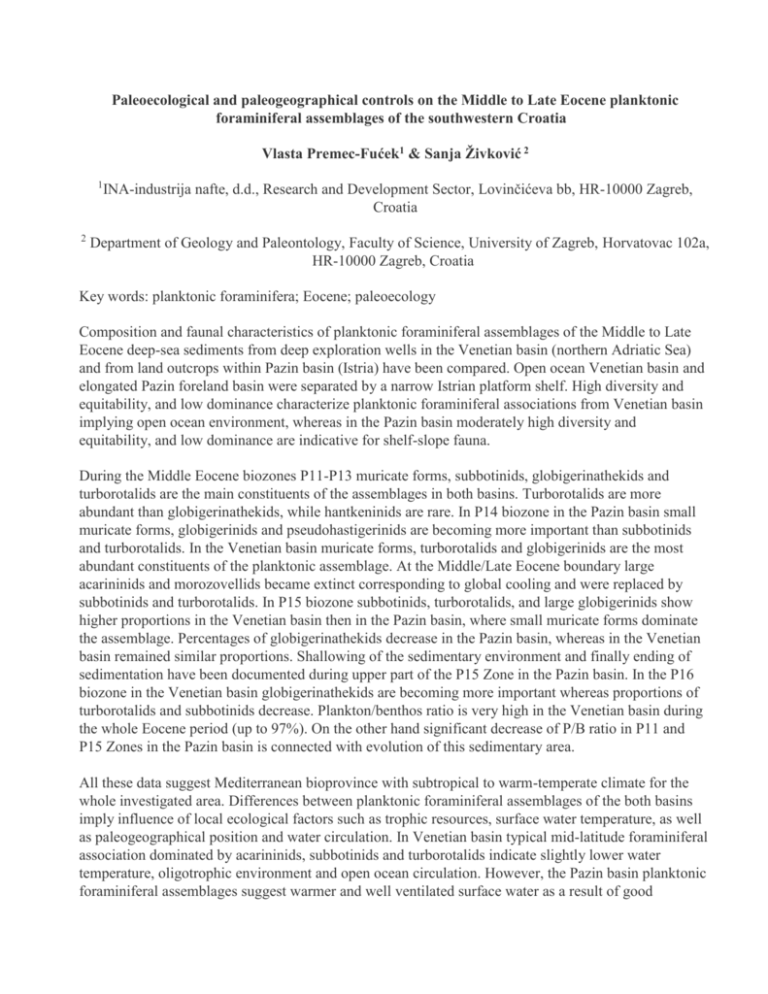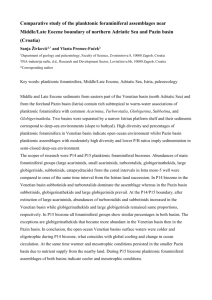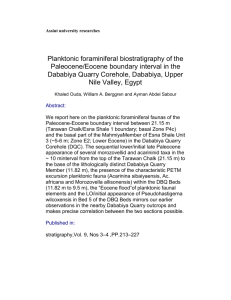206756.Premec-FucekZivkovic
advertisement

Paleoecological and paleogeographical controls on the Middle to Late Eocene planktonic foraminiferal assemblages of the southwestern Croatia Vlasta Premec-Fućek1 & Sanja Živković 2 1 2 INA-industrija nafte, d.d., Research and Development Sector, Lovinčićeva bb, HR-10000 Zagreb, Croatia Department of Geology and Paleontology, Faculty of Science, University of Zagreb, Horvatovac 102a, HR-10000 Zagreb, Croatia Key words: planktonic foraminifera; Eocene; paleoecology Composition and faunal characteristics of planktonic foraminiferal assemblages of the Middle to Late Eocene deep-sea sediments from deep exploration wells in the Venetian basin (northern Adriatic Sea) and from land outcrops within Pazin basin (Istria) have been compared. Open ocean Venetian basin and elongated Pazin foreland basin were separated by a narrow Istrian platform shelf. High diversity and equitability, and low dominance characterize planktonic foraminiferal associations from Venetian basin implying open ocean environment, whereas in the Pazin basin moderately high diversity and equitability, and low dominance are indicative for shelf-slope fauna. During the Middle Eocene biozones P11-P13 muricate forms, subbotinids, globigerinathekids and turborotalids are the main constituents of the assemblages in both basins. Turborotalids are more abundant than globigerinathekids, while hantkeninids are rare. In P14 biozone in the Pazin basin small muricate forms, globigerinids and pseudohastigerinids are becoming more important than subbotinids and turborotalids. In the Venetian basin muricate forms, turborotalids and globigerinids are the most abundant constituents of the planktonic assemblage. At the Middle/Late Eocene boundary large acarininids and morozovellids became extinct corresponding to global cooling and were replaced by subbotinids and turborotalids. In P15 biozone subbotinids, turborotalids, and large globigerinids show higher proportions in the Venetian basin then in the Pazin basin, where small muricate forms dominate the assemblage. Percentages of globigerinathekids decrease in the Pazin basin, whereas in the Venetian basin remained similar proportions. Shallowing of the sedimentary environment and finally ending of sedimentation have been documented during upper part of the P15 Zone in the Pazin basin. In the P16 biozone in the Venetian basin globigerinathekids are becoming more important whereas proportions of turborotalids and subbotinids decrease. Plankton/benthos ratio is very high in the Venetian basin during the whole Eocene period (up to 97%). On the other hand significant decrease of P/B ratio in P11 and P15 Zones in the Pazin basin is connected with evolution of this sedimentary area. All these data suggest Mediterranean bioprovince with subtropical to warm-temperate climate for the whole investigated area. Differences between planktonic foraminiferal assemblages of the both basins imply influence of local ecological factors such as trophic resources, surface water temperature, as well as paleogeographical position and water circulation. In Venetian basin typical mid-latitude foraminiferal association dominated by acarininids, subbotinids and turborotalids indicate slightly lower water temperature, oligotrophic environment and open ocean circulation. However, the Pazin basin planktonic foraminiferal assemblages suggest warmer and well ventilated surface water as a result of good communication with open ocean water, that were favorable to distribution of symbionts bearing globigerinathekids and muricate taxa. References: PREMEC FUĆEK, V. (1995): Biostratigraphy of the Middle and Late Eocene in the Northern Adratic offshore based on planktonic foraminifera. M. Sc. Thesis, University of Zagreb, Croatia, 87 pp., 38 Pls., 14 Figs., Zagreb (in Croatian, with English abstract). PREMEC-FUĆEK, V., BABIĆ, LJ., BAJRAKTAREVIĆ, Z. & GUŠIĆ, I. (1998): Planktonic foraminiferal biostratigraphy and paleoecology of the Middle to Upper Eocene succession in the north Adriatic Sea. Dela-Opera SAZU 4. Razr., 34/2, 255-271, Ljubljana. ŽIVKOVIĆ, S. (2004): Smaller benthic foraminifera in the Eocene clastics of western Croatia: paleoecology of the sedimentary basin. Ph. D. Thesis. University of Zagreb, Croatia, 101 pp., 3 Pls., 28 Figs., 7 Tbs., Zagreb (in Croatian, with English summary). ŽIVKOVIĆ, S. & BABIĆ, LJ. (2003): Paleoceanographic Implications of Smaller Benthic and Planktonic Foraminifera from the Eocene Pazin Basin (Coastal Dinarides, Croatia). Facies, 49, 49-60. Slike: Figures: Slika 1: Pojednostavljena geološka karta s položajem istraživanih geoloških stupova i istražnih bušotina Figure 1: Simplified geological map showing localities of the sections and deep-exploration wells studied Slika 2: Dijagrami koji pokazuju udjele važnih foraminiferskih grupa u Pazinskom i Venecijanskom bazenu Fig. 2: Diagrams showing the percentages of the important foraminiferal groups in Pazin basin and Venetian basin







